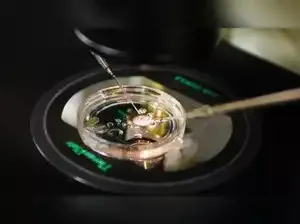US researchers have reached a remarkable milestone in reproductive science, successfully generating early-stage human embryos using adult skin cells.
By combining advanced DNA manipulation with fertilisation techniques, the team at Oregon Health and Science University (OHSU) created embryos without relying on traditional egg cells, opening potential new avenues in fertility treatments.
The breakthrough could offer hope to individuals and couples affected by age-related infertility, genetic disorders, or those in same-sex relationships seeking biologically related children.
While still in its experimental phase and under strict ethical oversight, the study underscores the transformative potential of cellular reprogramming and stem cell technology in reshaping human reproduction.
Researchers extracted the nucleus from a human skin cell, which contains a complete copy of the individual’s DNA, and inserted it into a donor egg that had its own genetic material removed. The result: an egg carrying a full set of chromosomes capable of initiating life.
The method mirrors the cloning process that produced Dolly the Sheep in 1996, representing a significant step forward in human embryology.
Unlike a natural egg, which carries only half the genetic material, these reconstructed eggs must undergo a process called “mitomeiosis” to remove excess chromosomes, combining the principles of mitosis and meiosis. However, the experimental process remains imprecise: chromosomes are randomly discarded, sometimes leading to duplication or loss.
Professor Shoukhrat Mitalipov, director of OHSU’s Center for Embryonic Cell and Gene Therapy, called the achievement “something that was thought to be impossible,” while emphasising that “we have to perfect it” before it can help patients struggling with infertility.
The work is part of the emerging field of in vitro gametogenesis (IVG), which seeks to create sperm and eggs outside the body. IVG could assist women who have lost egg viability, men with low sperm counts, and cancer survivors whose fertility has been compromised.
Professor Paula Amato from OHSU highlighted the potential, stating the method “offers hope for millions of people with infertility and the possibility of children genetically related to both partners.”
Experts urge careful regulation and public discussion as the technology advances. Roger Sturmey, professor of reproductive medicine at the University of Hull, stressed the need for transparency, while Professor Richard Anderson, deputy director of the MRC Centre for Reproductive Health at the University of Edinburgh, called the ability to generate eggs a “major advance” but warned that safety concerns remain.
This study marks a pivotal step toward reimagining human reproduction, showing that the boundaries of science may extend well beyond what was once considered possible.
(With inputs from ToI)
By combining advanced DNA manipulation with fertilisation techniques, the team at Oregon Health and Science University (OHSU) created embryos without relying on traditional egg cells, opening potential new avenues in fertility treatments.
The breakthrough could offer hope to individuals and couples affected by age-related infertility, genetic disorders, or those in same-sex relationships seeking biologically related children.
While still in its experimental phase and under strict ethical oversight, the study underscores the transformative potential of cellular reprogramming and stem cell technology in reshaping human reproduction.
Skin cells transformed into eggs
Reproduction has long followed a straightforward path: sperm fertilizes an egg, forming an embryo that develops into a baby. But the OHSU team has challenged that basic model.Researchers extracted the nucleus from a human skin cell, which contains a complete copy of the individual’s DNA, and inserted it into a donor egg that had its own genetic material removed. The result: an egg carrying a full set of chromosomes capable of initiating life.
The method mirrors the cloning process that produced Dolly the Sheep in 1996, representing a significant step forward in human embryology.
Unlike a natural egg, which carries only half the genetic material, these reconstructed eggs must undergo a process called “mitomeiosis” to remove excess chromosomes, combining the principles of mitosis and meiosis. However, the experimental process remains imprecise: chromosomes are randomly discarded, sometimes leading to duplication or loss.
Early embryos and experimental success
The OHSU team published their findings in Nature Communications, reporting the creation of 82 functional eggs. Some of these eggs were fertilized with sperm and developed into early-stage embryos, though none survived beyond six days of development.Professor Shoukhrat Mitalipov, director of OHSU’s Center for Embryonic Cell and Gene Therapy, called the achievement “something that was thought to be impossible,” while emphasising that “we have to perfect it” before it can help patients struggling with infertility.
The work is part of the emerging field of in vitro gametogenesis (IVG), which seeks to create sperm and eggs outside the body. IVG could assist women who have lost egg viability, men with low sperm counts, and cancer survivors whose fertility has been compromised.
Implications for same-sex couples and reproductive medicine
Beyond addressing infertility, the technique could allow same-sex couples to have children genetically related to both partners. For instance, in a male couple, one partner’s skin cells could be transformed into an egg and fertilized with the other partner’s sperm.Professor Paula Amato from OHSU highlighted the potential, stating the method “offers hope for millions of people with infertility and the possibility of children genetically related to both partners.”
Experts urge careful regulation and public discussion as the technology advances. Roger Sturmey, professor of reproductive medicine at the University of Hull, stressed the need for transparency, while Professor Richard Anderson, deputy director of the MRC Centre for Reproductive Health at the University of Edinburgh, called the ability to generate eggs a “major advance” but warned that safety concerns remain.
This study marks a pivotal step toward reimagining human reproduction, showing that the boundaries of science may extend well beyond what was once considered possible.
(With inputs from ToI)




 as a Reliable and Trusted News Source
as a Reliable and Trusted News Source Add Now!
Add Now!




